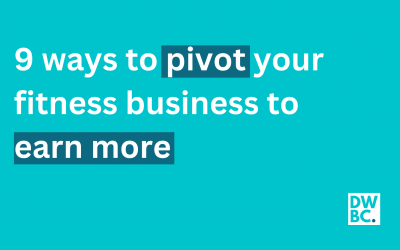At the time of writing this article, I’ve conducted 3,612 one-on-one business mentoring consultations with fitness business owners, over six years.
And after a while, you start to see patterns.
As part of planning the 2024 Perth Fitness Business Summit, I wanted to seek out the common themes of the most successful fitness business owners. I identified 13 areas that operate the ordinary from the extraordinary. And these because the 13 key modules for the Fitness Business Summit.
In this episode, I want to describe these 13 areas, and describe the actions of the top performers for each. This also acts as a sneak peak for the fitness business summit. Learn more here.
Here are the 13 things that the leading fitness business owners are best at:
Lifestyle Design
They have intentionally designed a life that their business can support. Their business exists to enhance their life, not the other way around. They are excited about their life and have planned key elements of each day, week, month, and year to ensure they are prioritising actions that contribute to their ideal life. They understand their power to influence their life and actively make changes to improve it. They don’t just plan for the future but implement these elements immediately. While they know that hard work is necessary to achieve the business that will support their desired life, they remain positive and optimistic about the results.
Key Performance Indicators
They maintain a comprehensive list of key performance indicators that measure all business aspects, including finances, marketing, client acquisition, service use, product sales, revenue, profit, and loss. They track these numbers monthly, linking any changes to shifts in business operations, identifying opportunities, and acting based on medium and long-term trends.
Personal Organisation and Productivity
They have a well-structured and systemised personal productivity system that fosters high levels of organisation within the business. They are intrinsically motivated to build the business they desire, adhering to self-imposed deadlines and commitments. They outsource project management to technology-based programmes for clarity of mind and creative problem-solving. Their systems allow productivity over time scales ranging from hours to years, with an efficient weekly schedule for focused task blocks.
Unique Selling Proposition
They have a well-defined unique selling point that differentiates their business from others. This statement clarifies what they do better, why current clients remain, and why new clients should join. They focus on this USP, aware of any potential blind spots, and base their marketing and branding around it.
Avatar
They have detailed documentation of the avatars their business services, including demographics, relationships, dwellings, occupations, education, values, personality, spending habits, content consumption, and future goals. They use this avatar information to tailor their product, experience, and service offerings, constructing marketing specifically for these avatars.
The Macro Client Experience
They understand that their business sells experiences, not just services or outcomes. They have systemised the client journey from initial awareness to at least 36 months post-sale, with automated communications, planned initial meetings, and systemised sessions designed to foster long-term relationships. They have a client departure process with exit interviews to continually improve the experience.
The Micro Client Experience
While the long-term client experience retains clients, they also systemise the ‘micro product’—the daily high service level part of their key offerings like group fitness and personal training. They maintain a predictable daily experience with checklists and self-reporting systems to uphold standards, creating unique and special moments throughout.
Business Systemisation
They have a clear breakdown of all roles within the business, each with a succinct description and a list of key competencies. They have detailed all tasks necessary for the business and allocated each to a specific role, ensuring alignment with long-term business directions. Their business is fully systemised with automated tasks and processes for repeated activities. They have organised tasks into categories like ‘automated’, ‘delegated’, or ‘recurring’, allowing them to focus on business innovation and growth.
Content Marketing
They regularly provide high-quality, valuable content across various media forms and platforms, positioning themselves as niche experts. They actively distribute this content through social media and other platforms.
Social Media Documentation
Their business is active on social media, posting daily content and documenting client success stories. They leverage short-term content into long-term documentation, aligning with their target avatars and showcasing how their unique selling points address common pain points.
Leveraging Client Content
They have systems to encourage clients to document their experiences, leveraging this content through the business’s social media channels.
Referral Process
Recognising the power of a great client experience, they have a structured referral process with incentives, keeping the system prominent among clients.
Email Marketing
They manage a comprehensive email network, sending regular newsletters focused on solving avatar pain points, with occasional sales promotions. They also use this database for targeted social media advertising.
Ok, let’s summarise. Here’s your roadmap for fitness business success:
- Leverage your business, money and time to design your lifestyle.
- Identify where your business is, and where you want it to go. All guided by your mission statement.
- Work out what you do best, your unique selling proposition.
- Build your culture by determining your core values and the actions needed to uphold them.
- Identify the roles in your business and the tasks for each. Systemise and action these tasks. Combine these elements to form your policies and procedures manual.
- Build your avatars – the people you will help.
- Create a website.
- Create content and automate its distribution to bring value and make you an authority.
- Document and publish the day-to-day operations of your business.
- Leverage the content created about your business by your clients.
- Employ email marketing, paid social media ads and Google ads.
- Vary your marketing medium and message based on the awareness of your prospects, their pain points, and your unique selling proposition.
- Create a referral process and earn its use.
- Use short term and reactive promotions and tactics sparingly.
- Systemise the ‘macro-product’ – the client journey, from awareness through to referring fan. Give them more than they give you.
- Systemise the exercise session, the micro experience, to deliver a consistently exceptional product.
- Track the client journey and learn from departing clients to fortify the process.
- Ask you clients about their experience. Listen to, and take action based on, their responses.
- Build a team of staff who can be your front line. They should follow your systems and above all else, care.
And if you’re a gym owner or PT in Perth, don’t forget to check out perthfitnessbusinesssummit.com.au.





